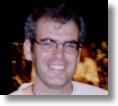|
D a v i d A l e x a n d e r Solar Physicist Lockheed Martin Solar and Astrophysics Laboratory, Palo Alto CA A Week in Paris
The reason for the workshop was to investigate the dynamical behavior of an active region (sunspot group) which crossed the visible solar disk in late May 1998. In other words, we were interested in how the active region changed over time. This sounds like rather a narrow topic for such a long trip but it is important for two main reasons. First, active regions are crucial to understanding how the Sun works. They are regions of strong and complex magnetic fields which exhibit a wide range of phenomena, from slowly varying coronal loops to explosive and dramatic solar flares. Second, the active region chosen as the focus of the workshop (active region AR8277) was observed continuously by a number of telescopes in space and on the ground. This campaign of observations yielded a wealth of data covering a period of two weeks in the life of AR8277. The clincher was the superb data from the TRACE satellite (Transition Region And Coronal Explorer) which provides a remarkable look at the solar atmosphere in ultraviolet and extreme ultraviolet wavelengths. The TRACE telescope is so good that we can distinguish objects that are about 700 km in size. This is equivalent to seeing the head of a penny at a distance of about 2 miles. |
